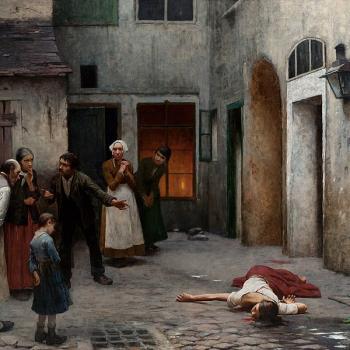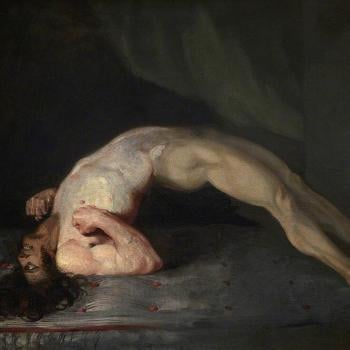Evil begats evil. It also glorifies it.
 Dr Jack Kevorkian, the serial killer with a schtick, died the old-fashioned way, under medical care, fighting for his life. Before his death, he was lionized, promoted and considered a martyr. Sixty Minutes played a tape of Dr Kevorkian administering death-dealing drugs to Thomas Youk of Michigan on prime time tv, along with a favorable interview. HBO spent millions producing and promoting You Don’t Know Jack, a film honoring Kevorkian. Academy award winning actor Al Pacino portrayed him in this sales piece for euthanasia of the elderly, the ailing, the disabled, or anyone else who might become inconvenient and unable fight back.
Dr Jack Kevorkian, the serial killer with a schtick, died the old-fashioned way, under medical care, fighting for his life. Before his death, he was lionized, promoted and considered a martyr. Sixty Minutes played a tape of Dr Kevorkian administering death-dealing drugs to Thomas Youk of Michigan on prime time tv, along with a favorable interview. HBO spent millions producing and promoting You Don’t Know Jack, a film honoring Kevorkian. Academy award winning actor Al Pacino portrayed him in this sales piece for euthanasia of the elderly, the ailing, the disabled, or anyone else who might become inconvenient and unable fight back.
Kevorkian, who spoke of establishing “obitoriums” where people would go to die and doctors would harvest organs and perform medical experiments, didn’t confine his killing to people who were near death. Some, such as the man whose murder Sixty Minutes televised, had serious illnesses which could, after many years, lead to death. But they weren’t dying. They needed help, support and love, not to be murdered.
According to the Patient Rights Council, Kevorkian testified under oath that he favored doing medical experiments on candidates for euthanasia. In a startling parallel with Nazi death camp practices, he “described a process by which ‘subjects,’ including infants, children and mentally incompetent people would be used for experiments ‘of any kind of complexity.’ Then, ‘if the subject’s body is alive’ after experimentation, ‘death may be induced’ by such means as ‘removal of organs for transplantation’ or ‘a lethal dose of a new and or untested drug.’”
None of this derailed the press support of euthanasia. HBO followed You Don’t Know Jack by running a documentary in support of one of Kevorkian’s stepchildren, the Oregon euthanasia law. Ironically, Kevorkian spoke against this law. He considered it too mild.
Why does so much of the media support making our doctors into our executioners? What is it about the elderly, the sick, and the disabled that renders their lives valueless in the eyes of the rich and powerful? Why do they “sell” euthanasia this way? Why are these people so in love with killing that they use all their talents and their enormous resources to peddle it to the rest of us?
Maybe it’s because evil not only begats and glorifies evil. It sells it.
Before his death, Kevorkian made as much as $50,000 dollars per engagement for speaking on our college campuses.
Dr Peter Singer, the Princeton “ethics” professor who promotes extending the right to kill the unborn to a legal right to kill infants after birth, also earns princely sums for speaking at our government-funded universities.
Evil evidently not only sells evil; it teaches it … and makes money in the process.
We, and our children — especially our children — are being “sold” on the sweetness of the fruits of the culture of death by some of the most talented and powerful people in the world today. While it may have begun with abortion, dealing death has become emblematic of what passes for intellectualism and trendiness throughout the American edutainment empire.
Child sacrifice/Human sacrifice are as much a part of our culture today as they were when people put their children through the flames for the Baals and Molochs of the ancient world. We’ve just changed the names of the gods.
For a long time, these death-dealing initiatives found their voice in what Mary Ann Glendon calls “rights talk.” Abortion was cast as a necessary human right for women. Euthanasia was given the advert of “death with dignity” and sold to us as the answer for suffering.
No one ever asked “whose suffering?” Were we, in fact, trying to alleviate the suffering of the dying person, or were we lifting the responsibility off the rest of us to take better care of them?
Abortion and euthanasia were marketed as “rights.” They were promoted as regrettable but necessary remedies for other evils. In recent years, the marketers of death have dropped the pretense of “rights.” They’ve moved to handing us the promises of gods by other names in direct and unapologetic form.
The new gods that demand human sacrifice sound a lot like the old ones. People put their children through the flames to propitiate the Baals and the Molochs. They offered human life in exchange for hope of a good harvest, or to end a plague, or for long life. The marketers of embryonic stem cell research promise economic development, cures for every known disease, and, maybe, just maybe, cracking the genetic code that dooms us to die. To paraphrase the songwriter, everything old is new again.
Today’s gods resurrect the ancient promise of life from death. They proffer the same things in exchange for becoming murderers that the demon gods of ancient times promised. They promise us what Christ alone can give: abundant life. But where Jesus taught us that life comes through the cross, through a willingness to suffer for one another and to love, cherish and care for each other, these new/old gods of expedience and greed promise us that they will give life in exchange for us becoming murderers of those on the fringes of life who can’t defend themselves in the court of public opinion.
They tell us over and again in many ways and through many venues that these are non-people, or that they’re not “real” people; that they don’t feel, think, look like us. In the morally bankrupt patois of our times, this is proof beyond a reasonable doubt that their near-human-but-not-quite-human lives are valueless. Our old/new gods of this world claim that this not-quite-human status of those on the fringes of life makes killing them an ok thing, a good thing, a kindness.
Horrifying as this is, it is not the bottom. Their arguments are in the process of morphing to the next step. The new arguments in the forward march of the culture of death revolve around the notion that it’s not just a “right” to kill those on the fringes, it’s a civic and moral responsibility. The elderly, it is said, use too much medical care, cost too much money. They are using “valuable resources” that should go to others who are more deserving. So … they have a “duty to die” for the good of future generations. Human embryos, so we are told, hold in their tiny bodies the Rosetta Stone of perfect health and unending life for the rest of us. Slaughtering them for their body parts is not just a right of scientists, it is the responsibility of politicians to pay for it.
This is how rights talk has become responsibility talk when it comes to killing. It’s how those of us who say no to the slaughter are cast as “nuts” and “irresponsible.” Murder has come a long way when the best and brightest among us openly argue that doing murder to those who can’t defend themselves is not a crime, but a civic responsibility, when they claim that opposing the murder of innocents is immoral. We are told that we can kill other people and it’s not even killing when we do it. It’s … “science.”
In truth, it’s a simple thing to kill. Anyone can do it. If you remove the legal penalties, killing appears to ask nothing of the killer, not even public condemnation. In the garden of lies that public discourse in this country has become, we are not allowed, ever, to say the obvious. Murder is a crime against humanity and against God, the real God. The blood of its victims cries out to heaven, just as Abel’s did. Murder, unrepented, will send you to hell.
A society that legalizes and funds the murder of its own people kills its own soul. Our society is disassembling itself. We are drowning in the lies we are told and that we tell ourselves. We have been propagandized and brainwashed to the point that we are fearful, on peril of slander and public attack, of simply saying who and what is a human being. That is not science. It’s not progress. That is insanity.
God told the ancient Israelites, “I set before you today life and death.” In this, as in so many things, everything old is indeed, new again.
Originally published in The Sooner Catholic. Reprinted here with permission.












